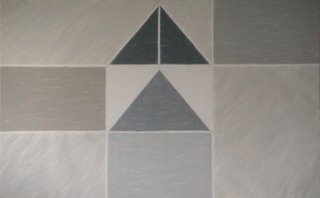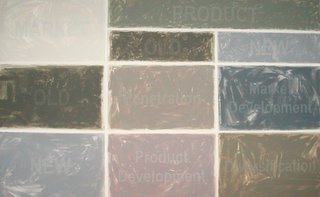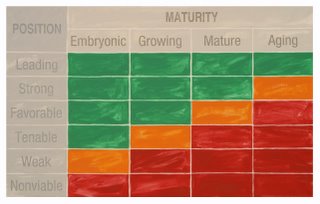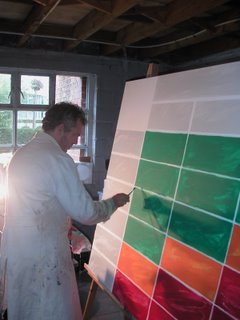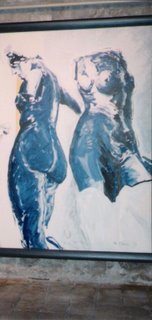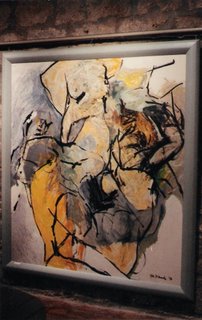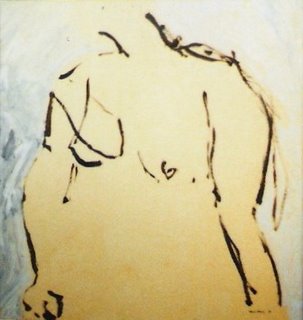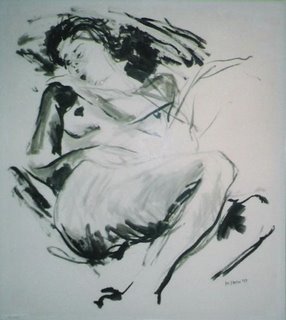Transcript of the interview rehearsal of TERI, the producer of the ITERRATIO programme, taken by his wife, Ann, on 060125
TERI – OK, have you read the questions? Let’s start.
Ann - What is ITERRATION ZERO about?
TERI - The ITERRATION ZERO event is the first step of the ITERRATIO programme. It is planned to be held in Belgium in 2007. It will be a multi disciplinary cultural event that will include, besides paintings, videos, drink, performances, food, books, etc…
Everything is still very much in motion. It is very exiting.
Ann - Food … drink …
TERI - Don’t look at me so disapprovingly. You’re supposed to interview me in a neutral way, remember? I will say no more at this point. Go on.
Ann - Why did you choose the rather unattractive theme of the “universality of business strategy”?
TERI – Read the questions as they have been written, please. You say the theme is unattractive. But you confuse the title and the theme. When one looks closer, the subject is fascinating, you said so yourself. It covers everything what is of interest to most people: money, power, ethics, success, failure, risk, opportunities, etc…
The reflection on, and the position of strategy within a culture, provides a very good image of that culture. The way people understand strategy is constitutive of their society and personality. I try to clarify this in my “Generic Strategy Options” model. Some elements in strategy are universal, both Xenophon and Sun Tse agree that environmental constraints determine the “freedom of action” of the war leader. The way in which this “freedom of action” is understood is, however, very much culturally and historically determined. A strategic concept, such as “indirect attack”, is very strange to the medieval western mind, but not, for instance, to the Byzantine strategists of the same period.
Capitalism has developed a set of techniques and methods to formalise business strategy. In the sense that capitalism has become ubiquitous, these techniques and methods have become universal. They are being applied even in “communist” China! They have become “common sense”, and not understanding their logic makes the world seem chaotic.
Ann – You sound pedantic, and I still think that you should find something else than the “universality of business strategy”, maybe something like “Strategy Games”. Next question: Why do you think people will be interested to attend ITERRATIO events?
TERI – If I were a cynic I would say: because it’s in their best interest! The pervasiveness of capitalism imposes increasingly to everyone to be an agent. In order to be an effective agent one has to understand the way the world is being logically structured. Not taking the time to reflect on business strategies today leads to estrangement and, in the worst cases, to marginalisation.
The flattening of organisational structures, the increasing demand for autonomous decision making and flexibility, the speeding up of change, these are all causes of an increasing strategic involvement of most people’s every day professional live. Not being able to understand the strategic performance framework in which one is supposed to function can lead to what Marx called “alienation”.
But I am not a cynic, as you know, my darling, or at least not totally. Some people have identified strategy to poetry, philosophy or have reduced it to data crunching, you know, things like the last hype: “competitive intelligence”. For my part, I think that strategy is the result of a conversational process which can be very enjoyable. I have made a glossary of the terms mentioned on the ITERRATIO paintings, and I am convinced that each single one of them, let alone the relationship between them, can be the source of an exciting conversation.
Ann – Are you setting up a capitalist propaganda forum?
TERI – Come on, stick to the questions, only a leftist journalist would ask stupid questions like these.
Ann – Answer the question. I AM a leftist journalist. Didn’t you tell me that one of the golden rules you’ve learned at your SN Brussels Airlines seminar on media communication was never to say “no comment” or refuse to answer a question?
TERI – OK, I’ll play the game.
You know, I tend to agree with Peter Sloterdijk that capitalism is a constitutive part of Western civilisation and that it has probably been the most accepted export product of what he calls the “age of terrestrial globalisation”, the period between the discovery of America and the end of the 20th century. The current era is characterised by the saturation of the effects of the previous age. What is going on today is an absorption “in depth” of capitalistic modes of thinking and behaving, and business strategic thought is, in my view, a perfect example of this phenomenon.
It is not my goal to trigger antagonistic discussions about the epistemological or moral right or wrong of socio-economical preconceptions or phenomena like capitalism and globalisation. All I want to achieve is to enhance “strategy awareness” through the provision of a conversational platform.
Ann – I liked your reference to Sloterdijk, people like famous names to be mentioned, you should refer more to them, it’ll make you seem less megalomaniac than you are. Next question: If you don’t want to promote “preconceptions”, as you call them, are your intentions purely philanthropic? In other words, will it finally buy us a nicer, BIG house?
TERI – What a mutation! The leftist journalist transforms into a mother animal!
Fortunately, times have long gone since art and business were parallel universes. But, I'm afraid that the relationship between business and art remains problematic, unachieved. Although business has integrated the concept of culture, in terms of managerial or corporate culture and values, art remains a very accidental element in the business world. Occasionally a cultural event or a visit to an exhibition is organised, most of the time within the context of PR or HR activities. Art is very rarely understood and used as one of the most effective instruments to build a common experience and understanding. The art community, from its side, remains quite averse to what it perceives as the instrumentalisation of its genius.
Some artists, like Yvo D’Herde, have a more traditional conception of their position. Within the framework of the ITERRATIO programme, Yvo has accepted to function as a craftsman. The purpose of the paintings is to create a tension between the quality of the painted images and their usual representation in aseptic printing or powerpoint projections. You’ll agree with me, seeing Ansoff’s Product/Market Matrix painted by Yvo creates a shock, especially to people who have only associated it to it's slick representation in their MBA manuals.
I consider that contributing to the triggering of a strategic conversation and the awareness of strategy through artistically generated questioning is a very beneficial service to both individuals and organisations. It is a service worth paying for, and I see nothing wrong with that.
Ann – Neither do I, but I’m still not fully convinced of the value of your proposition. You’ll have to work harder on that one.
TERI – I will.
Ann – And that’s what you will do using the pompous title “Producer”?
TERI – I am not an artist, nor am I a scenographer, an art critic, or an event organiser. I leave these responsibilities to much more qualified professionals. Harald Szeemann has elevated exhibition organising to an art form in its own right. I lack the background to be a “curator”. My craft is the raising of funds and the management of the proceeds, but with a definite say on the final product. This is the way the role of the producer is defined in the American film industry.
Ann - You are referring to the art world, but your programme is about generating a conversation about the “universality of business strategies”. Wouldn’t it be more efficient to organise a series of conferences?
TERI – There are already plenty of conferences on business strategy, they cover the rational argumentation of the subject. The objective of the ITERRATIO programme is to initiate conversational argumentation; this is a completely different aim. The ITERRATIO programme is about awareness, not knowledge. It is about what precedes knowledge, it is about experience. Art is the ideal vector to create such an experience.
Ann - OK, now one of the more sensible questions on your list. Why did you select the number 12 and the Golden Section as formal themes for the ITERRATIO programme?
TERI – The choice for the number 12 has to do with practical considerations. First, it is high enough to cover a sufficient number of perspectives on business strategy. I can cover the internal and external, the market or process, static or dynamic orientations of the different models. On the other hand 12 is not too many. I don’t want to overdo it and confuse people. Finally, and this is great news, 12 can be divided by 1, 2, 3, 4 or 6. This can come in handy in the concrete elaboration of the event.
As for the Golden Section it is, besides the aesthetic qualities of the 1.618 ratio, a referral to the Western cultural tradition. Although far from being an occultist or a Pythagorean, I always have been fascinated by the Golden Section and the famous book on the subject by Matila C. Ghyka.
Ann – You may not be an occultist, but my Christian background forces me to an association with the 14 stations of the way of cross.
TERI – You surprise me. I didn’t think of that one. What can I say? Well, the similarity is purely fortuitous. The 14 stations of the way of the cross are focal points in a linear story. The 12 representations of strategy models are part of a non-linear network of signification. I’ll need to think more on this subject, thanks for the input.
Ann - Are you in touch with other artists?
TERI – Of course. I am currently talking to several people to make a first video, to architects, scenographers, etc… , but also to cooks and professionals in the event industry. One shouldn’t underestimate the creativity of these people.
I am also building an “advisory board” for the ITERRATIO programme. Besides artists, business people, academics, executives and politicians will contribute to the elaboration of the programme.
I am in touch with a lot of fascinating individuals. I have set up a blog (http://iterrationzero.blogspot.com/) for the people who wish to follow the development of the project.
Ann – What are your chances of success?
TERI – What could go wrong with a woman like you at my side?

